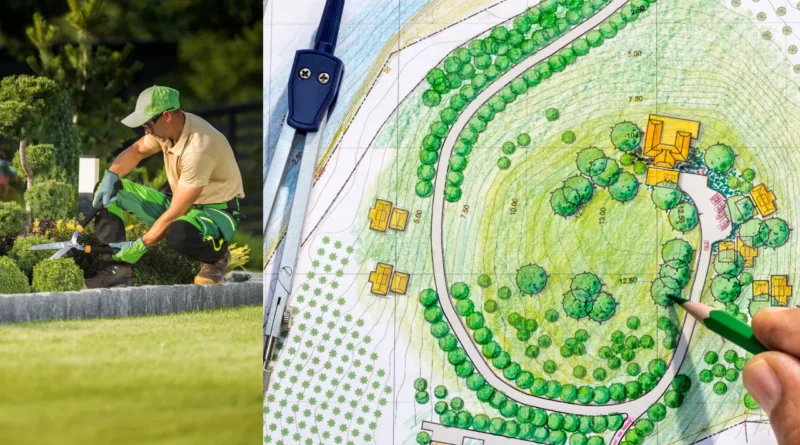10 Essential Tips for Creating a Stunning Landscape Garden
Table of Contents
Introduction to Landscape Gardening: Why It Matters
Landscape gardening is a blend of art and science, shaping outdoor spaces to enhance aesthetics and functionality. This practice transcends mere decoration, impacting the environment and personal well-being. Key benefits include:
- Environmental Impact: Plants improve air quality, conserve water, and prevent soil erosion.
- Health Benefits: Green spaces reduce stress and promote physical activity.
- Increased Property Value: Well-designed gardens boost curb appeal and market value.
- Biodiversity Support: Gardens provide habitats for various species, fostering ecological balance.
Professional landscape gardening combines creativity with horticultural expertise, creating visually stunning and sustainable environments.
Assessing Your Outdoor Space: Evaluating Potential and Limitations
To create a stunning landscape garden, one must first assess their outdoor space. Evaluating potential and limitations is crucial.
Key Points to Consider:
- Soil Quality: Determine soil type and pH levels to ensure suitability for desired plants.
- Sunlight: Note areas of full sun, partial shade, and full shade.
- Climate: Understand local climate patterns to select appropriate plant species.
- Drainage: Check for water accumulation that may affect plant health.
- Space Availability: Measure and plan for the placement of plants and structures.
- Existing Features: Identify current trees, pathways, and structures to incorporate into the design.
Planning Your Landscape: Sketching Ideas and Creating a Layout
Proper planning is crucial. Start by sketching ideas. Use graph paper for scale. Identify focal points, such as trees or water features.
- Assess the Site
- Evaluate sunlight.
- Check soil conditions.
- Define Zones
- Entertainment area.
- Vegetable garden.
- Consider Functionality
- Paths for ease of movement.
- Seating areas for relaxation.
- Incorporate Elevations
- Terraces or steps.
- Plan for Drainage
- Avoid water logging.
- Select Appropriate Plants
- Drought-resistant for dry areas.
Tip: Utilize landscape design software for precise planning.
Essential Tools and Materials for Beginners
Investing in the right tools and materials ensures efficiency and success in landscape gardening. Here are some essentials:
Garden Tools
- Spade: For digging and planting.
- Rake: To level soil and collect debris.
- Pruning Shears: For trimming plants.
- Garden Fork: For aerating soil.
- Hose: Essential for watering plants.
Materials
- Compost: Improves soil fertility.
- Mulch: Retains moisture and suppresses weeds.
- Plants: Native plants and perennials suit beginners.
- Seeds: For growing flowers, vegetables, or herbs.
- Pots: For starting seeds or container gardening.
Safety Gear
- Gloves: Protect hands from thorns and dirt.
- Knee Pads: For comfortable kneeling.
Choosing the Right Plants for Your Climate and Soil
Understanding regional climate zones is essential. Consult the USDA Plant Hardiness Zone Map or a similar resource. Soil type—clay, loam, sand—impacts plant health. Conduct a soil test to determine pH levels and nutrient composition.
- Climate Compatibility: Select plants native to or adaptable to your zone.
- Soil Type: Match plants to the garden’s soil type.
- Water Needs: Group plants by similar irrigation needs.
- Sunlight Requirements: Note areas receiving full sun, partial shade, or full shade.
- Maintenance Levels: Choose low-maintenance plants if time-constrained.
Following these guidelines ensures a thriving, beautiful garden.
Creating Focal Points: Using Trees, Shrubs, and Flowers
In landscape design, focal points draw the eye and create visual interest. Use trees, shrubs, and flowers to establish these focal points effectively.
- Trees: Choose species that thrive in your climate. Position larger trees as anchor points in the garden.
- Shrubs: Use shrubs to create structure. They can define boundaries or act as backdrop elements.
- Flowers: Select a variety of flowers that bloom in different seasons. This ensures continuous color and attraction throughout the year.
“A garden without focal points is like a story without a plot.”
Incorporating Hardscaping: Patios, Walkways, and Decks
Elevating a landscape garden includes integrating hardscape elements. Patios offer outdoor living spaces for entertaining or relaxation. Choosing durable, non-slip materials ensures longevity and safety. Walkways guide visitors, enhance accessibility, and protect plant beds from foot traffic. Materials like stone, pavers, or gravel must blend with the garden’s theme.
Decks extend living spaces and create vantage points for scenic views. Selecting weather-resistant wood or composite materials prevents deterioration. Proper construction with adequate drainage avoids water damage. Thoughtful lighting can accentuate features and provide functionality at night. Balancing hardscape with greenery maintains a harmonious garden aesthetic.
Water Features and Irrigation Systems: Adding Elegance and Functionality
Water features such as fountains, ponds, and waterfalls can transform a garden into a serene oasis. Carefully selected and positioned, they become focal points and enhance the aesthetics.
Considerations for Water Features:
- Size and Scale: Match the water feature to the garden’s size.
- Maintenance: Choose low-maintenance options if time is a concern.
- Safety: Ensure child-safe installations if needed.
Proper irrigation systems are vital for plant health and water conservation.
Irrigation System Tips:
- Drip Irrigation: Offers precise water delivery, reducing waste.
- Sprinkler Systems: Suitable for larger lawns.
- Smart Controllers: Automate watering schedules based on weather data.
Sustainable Practices: Eco-Friendly Gardening Tips
Incorporating sustainable practices preserves natural resources and reduces environmental impact.
Composting
- Organic Waste: Convert kitchen scraps and yard waste into nutrient-rich compost.
- Soil Health: Enhances soil structure, water retention, and root growth.
Water Conservation
- Rainwater Harvesting: Collect and store rainwater for garden use.
- Drip Irrigation: Efficient water delivery directly to plant roots, reducing waste.
Native Plants
- Local Flora: Utilize plants suited to local climate and soil.
- Biodiversity: Supports local wildlife, providing habitat and food sources.
Mulching
- Weed Control: Suppresses weeds, conserving soil moisture.
- Temperature Regulation: Maintains consistent soil temperatures, benefiting plant health.
Seasonal Maintenance: Keeping Your Garden Beautiful Year-Round
Consistent seasonal maintenance is crucial for a flourishing landscape garden.
Spring
- Pruning: Remove dead or damaged branches from shrubs and trees.
- Fertilizing: Apply slow-release fertilizer to nourish plants.
- Planting: Introduce new perennials and annuals as the soil warms.
Summer
- Watering: Increase watering frequency due to heat.
- Weeding: Regularly remove weeds to prevent competition for nutrients.
- Deadheading: Remove spent flowers to encourage new blooms.
Fall
- Mulching: Add a fresh layer of mulch to retain soil moisture.
- Leaf Cleanup: Regularly clear fallen leaves.
- Bulb Planting: Plant spring-flowering bulbs before the ground freezes.
Winter
- Protecting: Use burlap or protective coverings for vulnerable plants.
- Planning: Assess garden layout and plan for upcoming planting seasons.
- Tool Maintenance: Sharpen and repair garden tools.
By following these steps, one ensures vibrant and healthy growth throughout the year.
Common Mistakes to Avoid in Landscape Gardening
- Neglecting Soil Quality: Soil health is paramount for plant growth. Ignoring soil composition, pH levels, or drainage can hinder plant development.
- Overlooking Sunlight Requirements: Failing to match plants with their sunlight needs can stress or kill them.
- Overplanting: Crowding plants leads to competition for nutrients and resources, resulting in stunted growth.
- Improper Watering: Either overwatering or underwatering can harm plants. Employ suitable irrigation practices.
- Neglecting Maintenance: Infrequent weeding, pruning, and fertilizing can deteriorate garden quality.
- Ignoring Climate: Selecting plants incompatible with local climatic conditions compromises garden sustainability.
- Lack of Planning: Skipping a design plan can lead to a disorganized look and impractical garden use.
- Incorrect Planting Depth: Planting too deep or too shallow affects root development.
- Not Considering Plant Maturity Size: Overlooking how large plants will grow can lead to overcrowding and aesthetic imbalance.
- Use of Invasive Species: Introducing invasive plants can disrupt local ecosystems and outcompete native species.
Inspiration and Resources: Where to Find Help and Ideas for Your Garden
To create a stunning landscape garden, one may seek inspiration and resources from various avenues:
Books and Magazines
- Gardening books: Offer detailed guides and inspiration
- Landscaping magazines: Trend updates and creative ideas
Online Communities
- Gardening forums: Peer advice and support
- Social media groups: Visual inspiration and expert tips
Local Nurseries and Garden Centers
- Expert advice: Tailored to local climate and soil
- Plant selection: Hands-on assistance
Public Gardens and Parks
- Visit for inspiration: Observe plant combinations and designs
- Workshops and tours: Learn from experts and enthusiasts
Conclusion: Enjoying Your Transformed Outdoor Space
Maximizing the benefits of a stunning landscape garden requires intentional care and attention to detail. Regular maintenance such as pruning, watering, and fertilizing ensures a lush environment. Adding outdoor furniture can create a cozy, inviting area for relaxation or entertainment. Integrating efficient lighting and decorative elements, like sculptures or water features, enhances the ambiance during evening hours. Celebrating seasonal changes with appropriate flora keeps the garden vibrant year-round. Encouraging wildlife by installing bird feeders or butterfly-friendly plants can create a lively ecosystem. A well-maintained garden becomes an enjoyable retreat for years to come.

